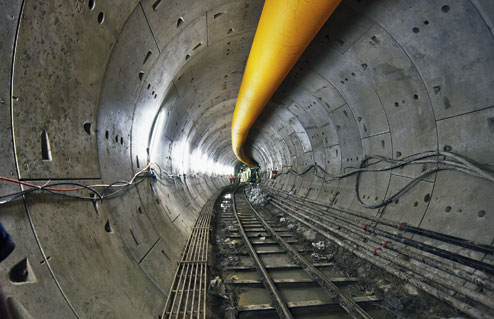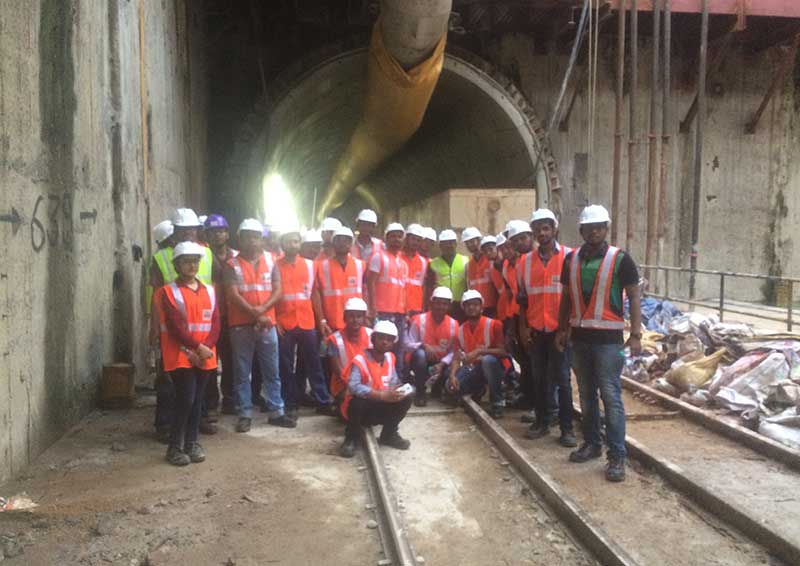East West Metro Tunnel, Calcutta
At least two unique features describe the much awaited underground railway connection between Calcutta (Kolkata) and Howrah, two large cities situated on either side of River Hooghly.
The idea was put forward by a Bengal-born British engineer Sir Harley Hugh Dalrymple-Hay in 1921, and its twin tunnels under River Hooghly are the first of its kind in India.
It has taken almost a century to realise Sir Dalrymple-Hay concept, and it is expected that the East West Metro Railway will have a significant and far reaching impact on Calcutta's transportation system in years to come and the way people commute between these two congested city centres.
In June 2017, 30 members from the ICE Kolkata Chapter visited the tunnels under construction.
The East-West Metro Corridor Project connects the East of Kolkata (Salt Lake Sector-V, Kolkata's IT Hub) with the west end, i.e, Howrah (Kolkata's twin city).
The whole project is being executed by Kolkata Metro Railway Corporation Limited (KMRCL) with partial financial support from JICA.
The entire stretch is divided into three parts:
- UG-1 (underground portion from Howrah Maidan to New Mahakaran).
- UG-2 (underground portion from Esplanade to Subhash Sarobar).
- Elevated portion from Subhash Sarobar to Salt Lake Sector-V.
This UG-1 contract package is being executed by TransTonnelstroy-AFCONS Joint Venture (TTAJV). A consortium (MYCEL) led by AECOM is the General Consultants (GC) to KMRCL.
The works include 2-tier Howrah Maidan Station, one cross-over near Howrah Maidan Station, a 4-tier Howrah Station adjacent to present Howrah Railway Station (Kolkata's Railway Hub to rest of India) to provide interface between underground and surface railway transportation for commuter traffic coming to the cities from suburbs.
Under the project, there are twin 5.5 m tunnels that are 3 km long and a vent shaft/emergency exit on Kolkata's side by Hooghly River.
The tunnels under the river pass through mostly clay silts at a depth of 11-15 m below the river bed and under submergence of 13 m average tide water in the river.
There are EPBM type two Tunnel Boring Machines (TBM) at work from Herrenknecht, Germany (named 'Rachana' meaning 'Composition', and 'Prerana' meaning 'Encouragement').
The tunnel is being constructed with pre-cast segments (5 regular segments and 1 key) of M50 grade concrete along with all necessary arrangement to ensure waterproofing, resistance to earthquake and flotation for a design life of 120 years.
During tunnelling (other than utilities and land issues), the biggest challenge is to ensure the safety of buildings and structures above ground (some of them are almost a century old and remnants of the colonial era) with suitable preventive measures.
Tunnels have successfully crossed Howrah DRM building with nominal damage and it is considered to be one of the key achievements in this project.
This article was originally published here by ICE on 15 June 2017. It was written by Ayanangshu Dey.
--The Institution of Civil Engineers
[edit] Related articles on Designing Buildings Wiki
- Articles by ICE on Designing Buildings Wiki.
- Excavating plant.
- From Calcutta to Kolkata - legacy and modernisation.
- India looks at using plastic instead of sand.
- India needs to build more infrastructure fast. Here's how.
- Indian construction industry.
- Indian infrastructure.
- Follo Line, Norway.
- Stad Ship Tunnel.
- Trenchless technology.
- Tunnel Engineering Exhibition 2017.
- Tunnelling.
- Tunnels of the world.
- Underpinning.
Featured articles and news
Homes England supports Greencore Homes
42 new build affordable sustainable homes in Oxfordshire.
Zero carbon social housing: unlocking brownfield potential
Seven ZEDpod strategies for brownfield housing success.
CIOB report; a blueprint for SDGs and the built environment
Pairing the Sustainable Development Goals with projects.
Types, tests, standards and fires relating to external cladding
Brief descriptions with an extensive list of fires for review.
Latest Build UK Building Safety Regime explainer published
Key elements in one short, now updated document.
UKGBC launch the UK Climate Resilience Roadmap
First guidance of its kind on direct climate impacts for the built environment and how it can adapt.
CLC Health, Safety and Wellbeing Strategy 2025
Launched by the Minister for Industry to look at fatalities on site, improving mental health and other issues.
One of the most impressive Victorian architects. Book review.
Common Assessment Standard now with building safety
New CAS update now includes mandatory building safety questions.
RTPI leader to become new CIOB Chief Executive Officer
Dr Victoria Hills MRTPI, FICE to take over after Caroline Gumble’s departure.
Social and affordable housing, a long term plan for delivery
The “Delivering a Decade of Renewal for Social and Affordable Housing” strategy sets out future path.
A change to adoptive architecture
Effects of global weather warming on architectural detailing, material choice and human interaction.
The proposed publicly owned and backed subsidiary of Homes England, to facilitate new homes.
How big is the problem and what can we do to mitigate the effects?
Overheating guidance and tools for building designers
A number of cool guides to help with the heat.
The UK's Modern Industrial Strategy: A 10 year plan
Previous consultation criticism, current key elements and general support with some persisting reservations.
Building Safety Regulator reforms
New roles, new staff and a new fast track service pave the way for a single construction regulator.

























